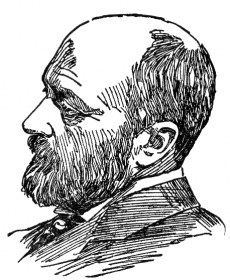
Henry James (1843-1916) was a novelist and short story writer who among many critics is regarded as one of the most important authors of the late-nineteenth century and early twentieth century. He is an author who bridged the gap between literary realism and literary modernism, because whilst he placed an emphasis on believability in his writing, he also used techniques that were later to be employed by modernist writers, including interior monologue and unreliable narration, also known as errata. As his career progressed, his writing became increasingly focused not on plot, but on the psychological state of his characters – yet another tendency of modernist writers.
The Portrait of a Lady, first published in 1881, is one of his earlier works and one of his more accessible novels. It follows the life of a young American Lady called Isabel Archer who has recently been taken on by her Aunt, Lydia Touchett, and brought to live with her and her family in their estate just outside London.
Despite the fact that women were taught to be submissive and obedient to their husbands, fathers and other male authorities in society, Isabel prizes personal independence above all else. This aspect of her character becomes apparent on one of the first nights of her stay, when she is talking to Mrs Touchett as they are going off to bed. Mrs Touchett is giving her a short lesson in European etiquette, telling her, “Young girls here – in decent houses – don’t sit alone with the gentlemen late at night.” This is because downstairs Isabel had said she wanted to stay talking with the men, something that Mrs Touchett infers is associated with indecency – a single woman apparently could not be trusted to be alone with a group of men.
But rather than act annoyed at this light telling off Isabel expresses her gladness at being told what to do wrong and says that “I always want to know the things one shouldn’t do.” However, she turns this seemingly obedient attitude around when Mrs Touchett says, “So as to do them?” responding, “So as to choose.” Isabel believes in her capability for making her own choices in life, regardless of social conventions and the opinions of those around her. It is this rebellious streak in her that makes her such a likeable character.
As a result, she refuses to marry even the most decent of men, like the noble Lord Warburton, on the basis that such a relationship would inhibit her freedom.
However, when her Uncle, Daniel Touchett, dies and she inherits sixty thousand pounds she becomes the target of a fortune hunter named Gilbert Osmond. He attempts to court her by portraying himself as an outsider like her and someone who values individual freedom and so when he asks, she (surprisingly) accepts his proposal. However, in marriage it becomes clear that Osmond is arrogant and has no love or affection at all for Isabel, keeping her firmly under his thumb.
In the final chapter of the novel, Isabel escapes Osmond’s grip for a time by returning to see her cousin and old friend Ralph Touchett, son of Daniel Touchett, who is ill and about to die. After their touching parting, Isabel is faced with the choice of whether to go back to Osmond or whether to leave him. However, James ends the novel without telling us which path she has chosen.
This short analysis and description does not do The Portrait of a Lady anywhere near the justice it deserves, and so I may come back to it in other articles and discuss certain characters and parts of the plot in more detail. But suffice it to say that it is probably one of the finest novels of the nineteenth century and a captivating read.
Image: https://commons.wikimedia.org/wiki/File:NSRW_Henry_James,_Jr.png

0 Comment:
Be the first one to comment on this article.